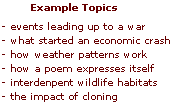![]()
Cause & Effect and If/Then Rules
Introduction
Sometimes you want to figure out what made something happen or how something works. Either way, you're looking into the causes (what made something happen) and the effects (the thing that happen). You can also call these "If / Then Rules," meaning "if" something happens, "then" we should be able to predict such-and-such an outcome. Being able to see such interactions can give you a lot of thinking power. Smart people use this strategy all the time to forecast the weather, anticipate how citizens will cast their votes, or predict how a patient will respond to treatment.

Sample topics could be almost anything that happens or changes. The point is to learn about either what made the thing happen, how that thing works, or how it interacts with its suroundings. The cause and effect strategy is all about analyzing changes. So it's the cause - effect, push - pull, input - output, If/Then of change that we are interested in.
Putting the Strategy into Action
- List or cluster around the topic you're analyzing.
For example: What things led up to it? How does it work or change? How is it impacted by things around it? Take about ten minutes to brainstorm as many ideas as you can.
- Look for the main influences or events
. What are the key things that need to be present for this topic to happen or work? What can't you leave out if this is to be what it is?
- Look for a pattern.
If it helps you understand the topic, use one of the patterns below. In short, there might be a series or chain-of-events that make this thing happen or it might involve a mixing of things all at one time. Use the graphics below to help you see if a series of actions created a chain of events or whether influences came together at a certain point to make something happen or work. These two models are used to help you analyze your topic, so don't let them confuse you!
You can think of the "Chain of Events" as a "domino effect:" one thing impacts another, which causes another, and another, until you're at the final outcome (the thing you're analyzing). Some ways people could use this pattern are describe the events that led to a war, the series of discoveries leading up to a new scientific theory, or how artistic movements were born.
You can think of "Converging Influences" as a cooking recipe: many ingredients come together to make a final product. All the ingredients are needed and if you change any one of the ingredients, you change the end product. People have used this approach to describe how environmental changes impact ecosystems, how tornados form, and what makes for an artistic masterpiece.
- Put your ideas to work
. When you can find 2 - 3 influences or actions that caused or effect your topic, you're ready to return to the Scaffolding page for Cause and Effect and fill in the form.Notice that this is not an easy process and you will probably feel confused at times. This is a natural part of thinking new thoughts. Feel free to ask your teacher or peers for feedback on your ideas.
http://www.web-and-flow.com/scaffolds/cause.html